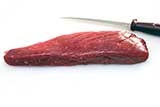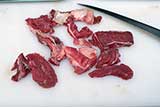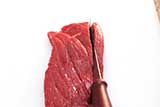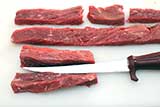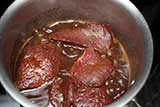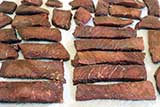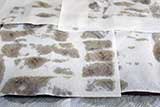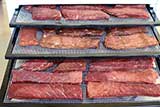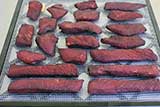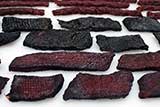Meats and Sausages
Whole Meat Jerky
Whole meat jerky is what people usually associate with the term jerky. It is a solid dried piece of meat that supplies plenty of protein and a decent amount of calories. Solid meat jerky has its own character; it is a chewable product. After a piece is bitten off, there is not much sensation, but once jerky is soaked with saliva its flavor comes to life. It takes a while to reconstitute jerky in a mouth until it is soft to eat. This constant chewing helps to beat the time for people on the move making it an ideal snack for hikers. For the same reason, it was a basic staple of American cavalry; in addition, it was light to carry.
The manufacturing process is rather simple:
- Selecting and preparing the meat.
- Marinating jerky strips.
- Precooking jerky strips.
- Drying.
- Storing jerky.
Selecting the Meat
The most popular cut for making jerky is the flank steak, which is cut from the abdominal muscles of the cow. In the USA flank steak is also known as London broil, although the name is unknown in the city of London.
Wild game meat is very lean and makes an excellent jerky. However, there are some safety issues when the meat is not heated to at least 137° F (59° C) internal temperature. The following meats may carry the parasite:
- Pork that comes from unknown sources.
- Wild boar, bear, raccoon, and other wild game.
The diet of deer (venison) does not include meat so deer meat is Trichinosis free. To protect the customer from pathogenic diseases like Salmonella and E.coli 0157:H7, the United States Department of Agriculture recommends cooking meat jerky strips to an internal temperature of 160° F (72° C) and poultry to 165° F (74° C). This treatment takes care of Trichinosis danger at the same time.
Preparing the Meat
Use only fresh lean meat. Remove any visible sinews, silver screen, or connective tissue. Those are great parts for emulsified sausages, but in jerky they will be very hard to chew. Discard any fat as it becomes rancid in time and will lower the flavor of jerky.
You can cut with or against the grain; some find that strips cut against the grain are easier to chew, resulting in a more crumbly product. It becomes easier to bite off and chew a piece of jerky. If you cut with the grain, it is chewier and takes longer to eat, which some people like. To facilitate cutting, the meat should be partially frozen – place the meat for 2 hours in a freezer. And, of course, you need a sharp knife.
You can cut meat into thicker slicers, but it will take much longer to dry them. Such thick cuts would probably not fit between the dehydrator’s trays. However, they may also be dried in the open air or in a smokehouse. South African biltong is a thickly sliced jerky. Before you attempt to dry bigger cuts of meat, you should read about drying meats, microbiology, and safety, adding a sufficient amount of salt and sodium nitrite (cure #1, if needed). There is a big difference between drying ¼” diameter jerky strip and one pound of solid meat. There is no need to add cure #1 (sodium nitrite), unless a strong red color is desired, or jerky will be smoked.
Marinating Jerky Strips
Better flavor is obtained when marinating meat strips instead of a solid cut of meat. There is a great selection of ready-to-use marinades in supermarkets, however, you can easily make your own. It will be cheaper and customizable. The three important ingredients of a good marinade are:
- Soy sauce.
- Worcestershire sauce.
- Liquid smoke. (There is no need for liquid smoke when drying jerky with smoke in a smokehouse).
Oil, vinegar, tomato ketchup, lemon juice, beer, dry wine, or can be used in every marinade. They also provide a degree of safety as acidic ingredients inhibit the growth of bacteria. Tabasco sauce will add hotness. Brown sugar, pepper, powdered garlic, and onion are often added. You may use other spices for original flavor, such as cumin, nutmeg, ginger, or curry powder.
A typical jerky marinade:
- 1 kg (2.2 lb) meat
- 1/2 cup soy sauce
- 1/4 cup Worcestershire sauce
- 1 tsp liquid smoke
- 1/2 tsp black pepper
- 1/2 tsp onion powder
- 1/2 tsp garlic powder
- Marinate meat in the refrigerator.
- Don't save and re-use marinade.
- Jerky strips heated in marinade will dry faster.
Safety Considerations
After Salmonella and E.coli 0157:H7 outbreaks in 1995 that were traced to manufacturing jerky, the USDA recommends that jerky be heated to 160° F (72° C). This can be accomplished in three ways:
1. Heat processing meat strips to 160° F (72° C) and poultry to 165° F (74° C). Since it is difficult to measure thin strips of meat with a thermometer, the accepted method is to boil the marinated jerky strips in marinade for 5 minutes and then dehydrate them for 4-6 hours. It is assumed that the thickness of the raw meat strip does not exceed ¼ inch. The reasoning behind the procedure is that any bacteria present will be destroyed with heat at 160° F (72° C ) and a lower dehydrator temperature of 130-140° F (54-60° C) will dry the meat. This temperature is considered to be the upper limit of the “danger zone” as at temperatures above 140° F (60° C) dangerous bacteria normally do not grow. There is, however, the downfall to this method - the texture of the finished jerky is crumbly, unlike the texture of home-made jerky that was never cooked.
2. Another acceptable approach is to dry meat above the danger zone at 145-155° F (63-68° C) for at least 4 hours or until jerky is deemed to be done, and then baking jerky in a preheated to 275° F (135° C) oven for 10 minutes. It is assumed that the thickness of the raw meat strip does not exceed ¼ inch. Thicker strips may require longer times to reach an internal temperature of 160° F (72° C).
3. The vinegar jerky preparation method given below was developed as part of a joint project between the Department of Food Science and Human Nutrition and the Department of Animal Sciences at Colorado State University and was found effective in reducing E. coli O157:H7 numbers and ensuring jerky safety.
Vinegar-Marinade Preparation Method
Ingredients per two pounds of lean meat slices:
Marinade ingredients:
- 1/4 cup soy sauce
- 1 tablespoon Worcestershire sauce
- 1/4 teaspoon black pepper
- 1/4 teaspoon garlic powder
- 1/2 teaspoon onion powder
- 1 teaspoon hickory smoked salt
Directions: Place 2 cups vinegar in 9 x11-inch cake pan or plastic storage container. Add meat strips to the container, making sure vinegar covers all strips; let soak 10 minutes, stirring occasionally to ensure distribution of vinegar on strips.
Combine all marinade ingredients and place in a 1-gallon re-sealable plastic bag. Add lean meat slices to the bag; seal and massage pieces to thoroughly distribute marinade over all meat strips. Refrigerate the bag for 10 to 24 hours.
Remove meat slices from the bag and place them flat, without touching each other, on clean dehydrator trays, oven racks, or other trays and immediately begin drying.
Drying
It is difficult to provide an exact number of hours needed to dry jerky. This depends on the thickness of the meat, temperature, humidity, and the type of dehydrator. Start checking jerky after 4 hours. Dried jerky cracks but does not break when it is bent.
If jerky was not heated in marinade prior to drying, the strips can be heated after drying as a safety precaution as described in Step 2 above.
When drying is completed remove any spots of oil with a paper towel. Cool. Pack in plastic zip-lock bags or in glass jars. If droplets of moisture appear, the jerky is still moist, so dry it for another hour or so.
Storing the Jerky
For best quality store dried jerky:
- In a sealed container for 1-2 weeks at room temperature
- Up to 6 months in refrigerator
- Up to 12 months in freezer
Vacuum package jerky to extend its shelf life.

